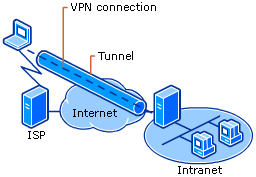VPN: Difference between revisions
Mr. MacKenty (talk | contribs) |
Mr. MacKenty (talk | contribs) |
||
| Line 71: | Line 71: | ||
== Audio recording of this page == | == Audio recording of this page == | ||
Many thanks to Jake for making this audio recording! <br /> | Many thanks to Jake for making this audio recording! <br /> | ||
== Standards == | == Standards == | ||
Revision as of 19:45, 16 May 2021

A virtual private network (VPN) extends a private network across a public network, and enables users to send and receive data across shared or public networks as if their computing devices were directly connected to the private network. Applications running across the VPN may therefore benefit from the functionality, security, and management of the private network.[2]
Required technologies[edit]

I thank the Dartford Grammar School for this material[3]
- A LAN that is connected to the internet.
- One computer outside of the LAN that is also connected to the internet.
- VPN client and server running on the lone machine and the original LAN
- Internet connection
In addition, you also need to understand VPN requires:
- encryption (the process of encoding a message or information in such a way that only authorized parties can access it[4])
- In cryptography, encryption is the process of encoding a message or information in such a way that only authorized parties can access it and those who are not authorized cannot. Encryption does not itself prevent interference but denies the intelligible content to a would-be interceptor.[5]
- tunneling (allows a network user to access or provide a network service that the underlying network does not support or provide directly[6])
- In computer networks, a tunneling protocol is a communications protocol that allows for the movement of data from one network to another. It involves allowing private network communications to be sent across a public network (such as the Internet) through a process called encapsulation.[7]
In addition, you also need to know VPN encryption requires:
- SSL 3.0 (Secure socket layer 3)
- TLS (with encryption) (Transport Layer Security)
- IPsec with encryption
Do I understand this?[edit]
If you are still stuck, or you have other questions, you may want to ask a question on our discussion board.
Two video explaining VPN basics[edit]
Evaluate the use of a VPN[edit]
Possible Advantages[edit]
- VPNs can provide increased privacy while online
- VPNs can provide enhanced security while online
- VPNs can provide flexible work hours
- VPNs can provide flexible work options, which in turn can be cost-effective
Possible Disadvantages[edit]
- VPNs could promote isolation
- VPNs could promote distractions
- VPNs could make developing professional relationships more difficult
A video describing some of the benefits of a VPN[edit]
Audio recording of this page[edit]
Many thanks to Jake for making this audio recording!
Standards[edit]
These standards are used from the IB Computer Science Subject Guide[8]
- Identify the technologies required to provide a VPN.
- Evaluate the use of a VPN.
References[edit]
- ↑ http://www.flaticon.com/
- ↑ https://en.wikipedia.org/wiki/Virtual_private_network
- ↑ http://ib.compscihub.net/wp-content/uploads/2015/04/3.1.4.pdf
- ↑ https://en.wikipedia.org/wiki/Encryption
- ↑ https://en.wikipedia.org/wiki/Encryption
- ↑ https://en.wikipedia.org/wiki/Tunneling_protocol
- ↑ https://en.wikipedia.org/wiki/Tunneling_protocol
- ↑ IB Diploma Programme Computer science guide (first examinations 2014). Cardiff, Wales, United Kingdom: International Baccalaureate Organization. January 2012.